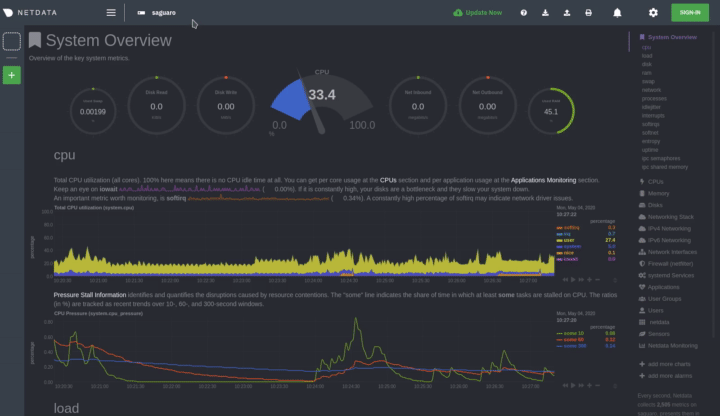1
2
3
4
5
6
7
8
9
10
11
12
13
14
15
16
17
18
19
20
21
22
23
24
25
26
27
28
29
30
31
32
33
34
35
36
37
38
39
40
41
42
43
44
45
46
47
48
49
50
51
52
53
54
55
56
57
58
59
60
61
62
63
64
65
66
67
68
69
70
71
72
73
74
75
76
77
78
79
80
81
82
83
84
85
86
87
88
89
90
91
92
93
94
95
96
97
98
99
100
101
102
103
104
105
106
107
108
109
110
111
112
113
114
115
116
117
118
119
120
|
<!--
title: "Configure the Netdata Agent"
description: "Netdata is zero-configuration for most users, but complex infrastructures may require you to tweak some of the Agent's granular settings."
custom_edit_url: https://github.com/netdata/netdata/edit/master/docs/configure/nodes.md
-->
# Configure the Netdata Agent
Netdata's zero-configuration collection, storage, and visualization features work for many users, infrastructures, and
use cases, but there are some situations where you might want to configure the Netdata Agent running on your node(s),
which can be a physical or virtual machine (VM), container, cloud deployment, or edge/IoT device.
For example, you might want to increase metrics retention, configure a collector based on your infrastructure's unique
setup, or secure the local dashboard by restricting it to only connections from `localhost`.
Whatever the reason, Netdata users should know how to configure individual nodes to act decisively if an incident,
anomaly, or change in infrastructure affects how their Agents should peform.
## The Netdata config directory
On most Linux systems, using our [recommended one-line installation](/docs/get/README.md#install-the-netdata-agent), the
**Netdata config directory** is `/etc/netdata/`. The config directory contains several configuration files with the
`.conf` extension, a few directories, and a shell script named `edit-config`.
> Some operating systems will use `/opt/netdata/etc/netdata/` as the config directory. If you're not sure where yours
> is, navigate to `http://NODE:19999/netdata.conf` in your browser, replacing `NODE` with the IP address or hostname of
> your node, and find the `# config directory = ` setting. The value listed is the config directory for your system.
All of Netdata's documentation assumes that your config directory is at `/etc/netdata`, and that you're running any
scripts from inside that directory.
## Netdata's configuration files
Upon installation, the Netdata config directory contains a few files and directories.
- `netdata.conf` is the main configuration file. This is where you'll find most configuration options. This doc won't
go into exhaustive detail about each setting. You can read descriptions for each in the [daemon config
doc](/daemon/config/README.md).
- `orig` is a symbolic link to the directory `/usr/lib/netdata/conf.d`, which contains stock configuration files.
Stock versions are copied into the config directory when opened with `edit-config`. _Do not edit the files in
`/usr/lib/netdata/conf.d`, as they are overwritten by updates to the Netdata Agent._
- `edit-config` is a shell script used for [editing configuration files](#use-edit-config-to-edit-netdataconf).
- `go.d/`, `python.d/`, `charts.d/`, `node.d`/, and `custom-plugins.d/`, which are directories for each of Netdata's
[orchestrators](/collectors/plugins.d/README.md). These directories can each contain additional `.conf` files for
configuring specific collectors.
## Use `edit-config` to edit `netdata.conf`
The **recommended way to easily and safely edit Netdata's configuration** is with the `edit-config` script. This script
opens existing Netdata configuration files using your system's `$EDITOR`. If the file doesn't yet exist in your config
directory, the script copies the stock version from `/usr/lib/netdata/conf.d` and opens it for editing.
Run `edit-config` without any options to see details on its usage and a list of all the configuration files you can
edit.
```bash
./edit-config
USAGE:
./edit-config FILENAME
Copy and edit the stock config file named: FILENAME
if FILENAME is already copied, it will be edited as-is.
The EDITOR shell variable is used to define the editor to be used.
Stock config files at: '/usr/lib/netdata/conf.d'
User config files at: '/etc/netdata'
Available files in '/usr/lib/netdata/conf.d' to copy and edit:
./apps_groups.conf ./health.d/phpfpm.conf
./aws_kinesis.conf ./health.d/pihole.conf
./charts.d/ap.conf ./health.d/portcheck.conf
./charts.d/apcupsd.conf ./health.d/postgres.conf
...
```
To edit `netdata.conf`, run `./edit-config netdata.conf`. You may need to elevate your privileges with `sudo` or another
method for `edit-config` to write into the config directory. Use your `$EDITOR`, make your changes, and save the file.
> `edit-config` uses the `EDITOR` environment variable on your system to edit the file. On many systems, that is
> defaulted to `vim` or `nano`. To change this variable for the current session (it will revert to the default when you
> reboot), export a new value: `export EDITOR=nano`. Or, [make the change
> permanent](https://stackoverflow.com/questions/13046624/how-to-permanently-export-a-variable-in-linux).
After you make your changes, you need to restart the Agent with `service netdata restart`.
Here's an example of editing the node's hostname, which appears in both the local dashboard and in Netdata Cloud.

### Other configuration files
You can edit any Netdata configuration file using `edit-config`. A few examples:
```bash
./edit-config apps_groups.conf
./edit-config ebpf.conf
./edit-config health.d/load.conf
./edit-config go.d/prometheus.conf
```
The documentation for each of Netdata's components explains which file(s) to edit to achieve the desired behavior.
## What's next?
Take advantage of this newfound understanding of node configuration to [add security to your
node](/docs/configure/secure-nodes.md). We have a few best practices based on how you use the Netdata Agent and Netdata
Cloud.
You can also take what you've learned about node configuration to tweak the Agent's behavior or enable new features:
- [Enable new collectors](/docs/collect/enable-configure.md) or tweak their behavior.
- [Configure existing health alarms](/docs/monitor/configure-alarms.md) or create new ones.
- [Enable notifications](/docs/monitor/enable-notifications.md) to receive updates about the health of your
infrastructure.
- Change [the long-term metrics retention period](/docs/store/change-metrics-storage.md) using the database engine.
[](<>)
|
